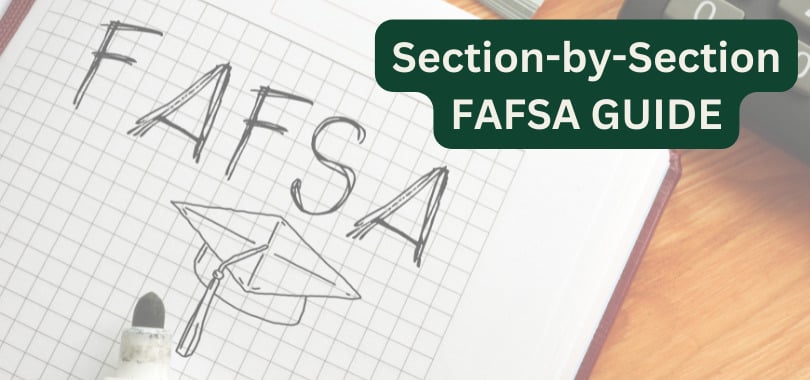The Free Application for Federal Student Aid (FAFSA), is an application that all students planning to go to college should complete. Below, we’ll do a quick review of what the FAFSA is and answer some of the more commonly asked questions. Here’s your FAFSA FAQ!
What is the FAFSA?

Flickr user the Bent Tree
The FAFSA stands for the Free Application for Federal Student Aid. It is the application you complete to apply for federal grants, loans, work study, and financial aid packages through your college or university. Provided by the Department of Education, the application and your responses are used to determine how much financial aid you’re eligible for.
The FAFSA is completely free and should not cost anything to complete.
15 Commonly Asked FAFSA Questions
1. When Is the FAFSA Released?
Most years, the FAFSA is released on October 1st for the following award year.
2. When is the FAFSA Due?
The FAFSA’s federal deadline is the end of the award year. So for the 2025-2026 award year, the FAFSA would be due by June 30th, 2025.
However, this is only the deadline for federal student aid, not for individual colleges. Schools have their own internal deadlines for the FAFSA and applying too late could lock you out of scholarships and grants you may have otherwise qualified for. Certain federal financial aid, like Pell Grants, can also run out sooner than June 30th. Federal student loans, though, are always available.
3. Am I Eligible to Complete the FAFSA?
With the new FAFSA, eligibility requirements are also changing. To be eligible, you must:
- Be a US citizen OR an eligible noncitizen with a valid Social Security number (there are some exceptions).
- Be enrolled or accepted for enrollment for a qualifying degree or program.
- Have your high school diploma or GED.
- Not be in default with federal student loans or owe money on federal grants.
- Maintain satisfactory academic progress.
Previously, males between the ages of 18 and 25 had to register with the Selective Service in order to complete the FAFSA. This is no longer the case for the 2024-2025 FAFSA.
4. How Long Does the FAFSA Take to Complete?
The FAFSA changes that took place in the 2024-2025 award year reduced the number of questions by far and that remains for the 2025-2026 year. Students will now need to answer fewer than 50 questions, depending on the applicant. That’s down from 108 questions on the old application. So, it should take you less than an hour to complete.
5. Can My Parents Help Me Complete the FAFSA?
Yes! Your parents or guardians can complete the FAFSA with you and they can help ensure you are entering in all the financial information correctly. However, anyone submitting information on the form will require their own FSA ID.
6. What Information Does the FAFSA Ask For?
The FAFSA asks for your contact information and you and/or your family’s income. Some specific information you will have to supply include:
- Your Social Security number
- If a dependent, your parents or guardians’ Social Security numbers
- Your driver’s license number if you have a driver’s license
- Federal tax information for you, your spouse, and/or your parents or guardians
- Untaxed income details
- List of assets
- Your Alien Registration number if you are not a citizen of the United States
7. Am I an Independent Student or a Dependent?
Most students completing the FAFSA will be considered dependents (and therefore be required to include parents’ income on their application). In order to be considered an independent student, students have to meet one or more of the following requirements:
- Be at least 24 years old
- Be a graduate student
- Be a veteran of the United States armed forces
- Be an emancipated minor
- Be in a legal guardianship
- You have children or other dependents
- You’re married or married and separated (not divorced)
- Your parents are deceased
8. What Should You Do If Your Parents Won’t Help You Complete the FAFSA?
In most cases, dependent students completing their FAFSA will require their parents’ participation. This is the case even if your parents are not helping you pay for college. In the event the parents refuse to submit their income or financial information, a dependency override may be obtained in extreme circumstances. We also recommend reaching out to the financial aid office at your school of choice(s). They may be able to work with you directly if there are unique circumstances.
9. Do I Have to Be a U.S. Citizen to Complete the FAFSA?
No, you do not have to be a U.S. citizen to complete the FAFSA. Some qualifying non-citizens include (but are not limited to):
- U.S. nationals
- Green card holders
- Citizens of the Federated States of Micronesia, the Republic of the Marshall Islands, or the Republic of Palau
- Immigrants with refugee or asylum status
If you are unsure if you can complete the FAFSA, you should reach out to your college’s financial aid office for further assistance.
10. What Federal Aid Does the FAFSA Grant?
Through the federal government and FAFSA, students can become eligible for federal student loans, work study programs, and grants such as the Pell Grant. Most students will qualify for some form of federal loans (specifically the Unsubsidized federal loan) regardless of their income.
11. Is the FAFSA Only for Federal Student Aid?
No, the FAFSA is used by colleges, universities, states, and other organizations to help determine your eligibility for grants and scholarships. Even if you don’t think you’ll qualify for federal grants, the FAFSA should be completed as you could be eligible for other programs.
12. Should I Fill Out the FAFSA Every Year?
Yes, no questions asked, students should complete the FAFSA every year, even if they only qualified for federal student loans the year before. Qualifications for the Pell Grant, state grants, and college scholarships and grants change every year and even if a student wasn’t eligible the year before, they could be eligible in the current year.
13. What FAFSA Terms Should I Know?
Some common FAFSA terms you should know include:
- Student Aid Index. Also known as SAI, the Student Aid Index is replacing the Expected Family Contribution (EFC). This number is used to determine how much financial aid you are eligible for.
- FSA ID. A legal signature, this is a username and password that is used for the Department of Education’s online systems. Everyone who supplies information to the FAFSA must have a FSA ID. You can sign up for the FSA ID here: Create Account | Personal Information | Federal Student Aid.
- Direct Subsidized Loan. A direct subsidized loan is a federal student loan in which the federal government pays the interest until after the grace period. The amount received is based on the school and your financial need.
- Direct Unsubsidized Loan. This is a loan where a student is responsible for the interest from the date of disbursement, however they will not need to pay it back immediately. Most students who complete the FAFSA will be offered a direct unsubsidized loan, as financial need is not considered.
- Pell Grant. The Federal Pell Grant Program is designed to help low-income students better afford college who have not previously earned a bachelor’s, graduate, or professional degree.
- Work Study Program. Work study programs offer students jobs on campus or with participating local employers to help offset the cost of tuition. Spots are limited and first come first serve.
14. When Will I Get My Results from FAFSA?
Students will generally receive their FAFSA results with their acceptance letters in the spring. These letters will include information on federal student loans, federal grant eligibility, work study eligibility, and any financial aid packages the college is offering should you decide to attend in the fall.
Students who applied under Early Decision or Early Action in November may have to wait until the following spring to receive their financial aid offer letters.
15. Where can I find more Answers to My FAFSA Questions?
If you have additional questions on FAFSA, visit FAFSA Updates | Federal Student Aid – Financial Aid Toolkit. This hub outlines the most up-to-date FAFSA changes and provides other important FAFSA information.
To learn more about FAFSA and other financial aid programs, grants, and affording college, be sure to head over to our articles on all things associated with the costs of higher education.





